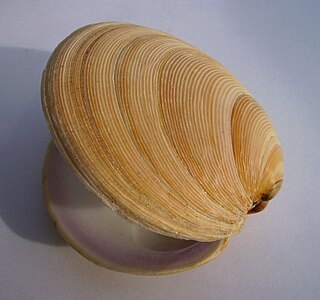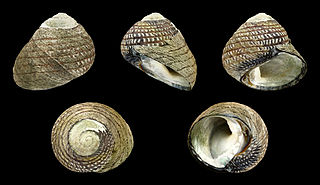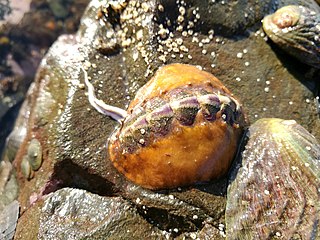
Scutus breviculus is a common herbivorous species of large sea snail or limpet with the common name shield shell or less commonly duck's bill limpet. It is a marine gastropod mollusc in the family Fissurellidae, the keyhole limpets and slit limpets.

Dosinia anus, commonly named the ringed dosinia, coarse dosinia, coarse biscuit shell and tuangi-haruru, in the Māori language, is a species of saltwater clam, a marine bivalve mollusc in the family Veneridae, the venus clams. The species is common to both of the main islands of New Zealand, where it is the largest and heaviest species in the genus, occasionally exceeding 80 mm in diameter. It buries itself in clean fine sandy substrata, sub-tidally down to 15 m deep.

Diloma aethiops, whose common names include scorched monodont, spotted black topshell, and in the Māori language pūpū, pūpū-mai, or māihi is a species of small sea snail, a marine gastropod mollusc in the family Trochidae, subfamily Monodontinae.

Diloma subrostratum, common name the mudflat top shell, is a species of small sea snail, a marine gastropod mollusk in the family Trochidae, the top snails.

Eudoxochiton nobilis, commonly called the noble chiton, is a large chiton of the family Callochitonidae. The Māori name is Rangitīra.

Chiton glaucus, common name the green chiton or the blue green chiton, is a species of chiton, a marine polyplacophoran mollusk in the family Chitonidae, the typical chitons. It is the most common chiton species in New Zealand. Chiton glaucus is part of a very primitive group of mollusc with evidence of being present in up to 80 million years of the fossil record.

Ischnochiton maorianus, sometimes called the variable chiton, is a fast moving species of chiton in the family Ischnochitonidae, endemic to the main islands of New Zealand where it is abundant.
Ischnochiton circumvallatus is a common medium-sized species of chiton in the family Ischnochitonidae, endemic to the southern South Island and the Subantarctic Islands of New Zealand where it habits exposed rocky shores down to the low intertidal zone. Coloured light buff to light green on both surfaces, occasionally with reddish brown. Moderately raised shell and narrow girdle which has small scales. Broods larvae along the sides of the body.
Maorichiton is a defunct genus of chitons in the family Mopaliidae.

Notoplax violacea is a species of chiton in the family Acanthochitonidae, endemic to all coasts of New Zealand, where it is common in northern areas.

Diloma coracinum is a species of small sea snail, a marine gastropod mollusc in the family Trochidae, the top snails. The Māori name is māihi.

Tucetona laticostata, or the large dog cockle, is a salt water clam or marine bivalve mollusc in the family Glycymerididae.

Austrolittorina cincta is a species of sea snail, a marine gastropod mollusk in the family Littorinidae, the winkles or periwinkles, found in and endemic to New Zealand. Commonly called the brown periwinkle, or ngaeti in the Māori language. Although present in all parts of the country, it is more common in the south. Size up to 15mm in length.

Leptochiton is a genus of polyplacophoran molluscs.

Plaxiphora albida, the white Plaxiphora chiton, is a species of chiton in the family Mopaliidae.
Pictobalcis is a currently monotypic genus in the family Eulimidae. As of 2016 the only known species is P. articulata.
Plaxiphora boydeni is a small uncommon chiton in the family Mopaliidae, endemic to the East Coast of the South Island, New Zealand, Stewart Island and the Chatham and Subantarctic Islands.
Plaxiphora caelata is a small chiton in the family Mopaliidae, endemic to the main islands of New Zealand, Stewart Island and the Chatham Islands.
Plaxiphora egregia is a distinctive chiton in the family Mopaliidae, endemic to the South Island of New Zealand, where it is uncommon.

Plaxiphora obtecta is a large chiton in the family Mopaliidae, endemic to New Zealand, where it is most often found on the West Coast of the North Island. It is called Haka-hiwihiwi by some Māori and was likely a food source.














